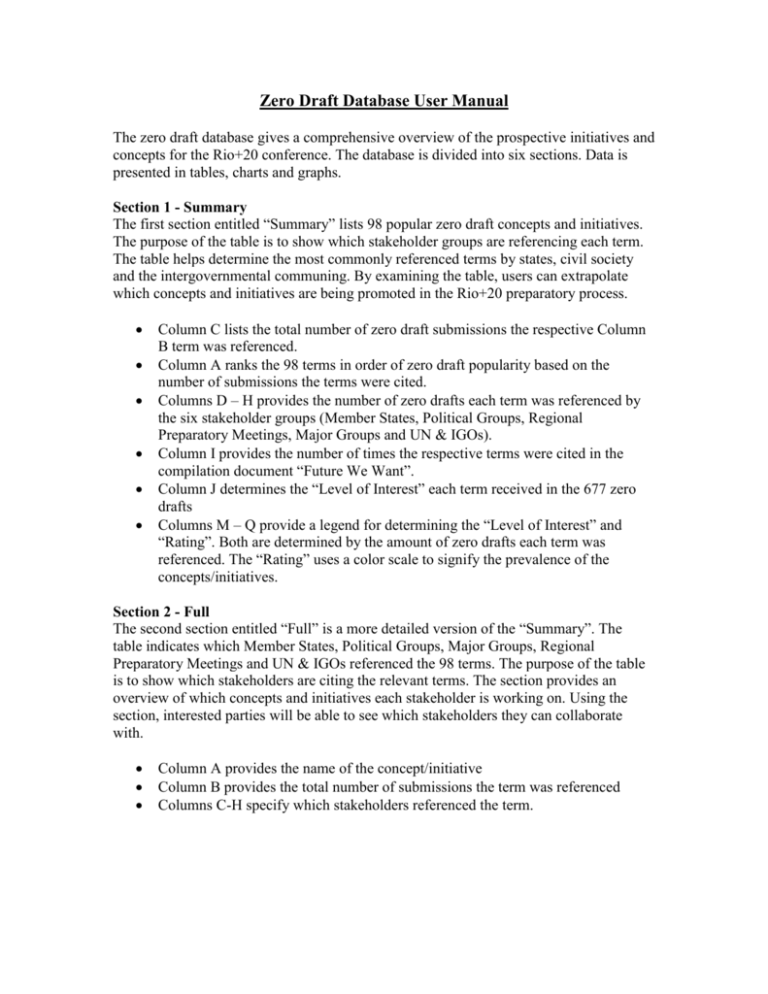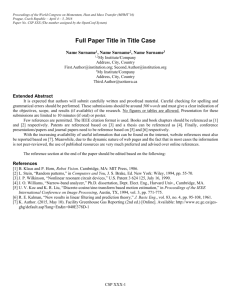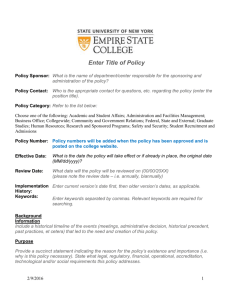Zero Draft Database User Manual
advertisement

Zero Draft Database User Manual The zero draft database gives a comprehensive overview of the prospective initiatives and concepts for the Rio+20 conference. The database is divided into six sections. Data is presented in tables, charts and graphs. Section 1 - Summary The first section entitled “Summary” lists 98 popular zero draft concepts and initiatives. The purpose of the table is to show which stakeholder groups are referencing each term. The table helps determine the most commonly referenced terms by states, civil society and the intergovernmental communing. By examining the table, users can extrapolate which concepts and initiatives are being promoted in the Rio+20 preparatory process. Column C lists the total number of zero draft submissions the respective Column B term was referenced. Column A ranks the 98 terms in order of zero draft popularity based on the number of submissions the terms were cited. Columns D – H provides the number of zero drafts each term was referenced by the six stakeholder groups (Member States, Political Groups, Regional Preparatory Meetings, Major Groups and UN & IGOs). Column I provides the number of times the respective terms were cited in the compilation document “Future We Want”. Column J determines the “Level of Interest” each term received in the 677 zero drafts Columns M – Q provide a legend for determining the “Level of Interest” and “Rating”. Both are determined by the amount of zero drafts each term was referenced. The “Rating” uses a color scale to signify the prevalence of the concepts/initiatives. Section 2 - Full The second section entitled “Full” is a more detailed version of the “Summary”. The table indicates which Member States, Political Groups, Major Groups, Regional Preparatory Meetings and UN & IGOs referenced the 98 terms. The purpose of the table is to show which stakeholders are citing the relevant terms. The section provides an overview of which concepts and initiatives each stakeholder is working on. Using the section, interested parties will be able to see which stakeholders they can collaborate with. Column A provides the name of the concept/initiative Column B provides the total number of submissions the term was referenced Columns C-H specify which stakeholders referenced the term. Section 3 - Top Ten The section presents the 10 most commonly used concepts/initiatives by stakeholder group. The “Top Ten” section shows the similarities and differences of stakeholder groups’ Rio+20 agendas. Column A provides a 1-10 concept/initiative popularity ranking. Columns B-I provides a list of each groups’ most frequently referenced terms. Section 4 - Breakdown The prevalence of the referenced concepts and initiatives in the zero drafts varies between stakeholder groups. For instance, popular terms referenced by member states might be used less often by political groups. The table highlights these discrepancies by ordering the 97 terms per stakeholder group based on the number of zero drafts they’re referenced. The “Breakdown” helps distinguish which concepts and initiatives are most popular amongst the different stakeholder groups. Column A is a list of 1-97, 1 being most popular. Columns C-D provides a ranking of member states’ most commonly referenced terms. Columns F-G provides a ranking of political groups’ most commonly referenced terms. Columns I-J provides a ranking of regional preparatory meetings’ most commonly referenced terms. Columns L-M provides a ranking of Major Groups’ most commonly referenced terms. Columns O-P provides a ranking of UN & IGOs’ most commonly referenced terms. Section 5 - Graph 1 Summary Corresponding graph to the data presented in the “Summary”. The X coordinate provides the name of the 98 initiatives/concepts and the Y coordinate shows how many zero drafts referenced the terms. The graph is an easy way to digest how many zero drafts referenced each term. Section 6 - Graph 2 Pie Corresponding pie chart to the “Level of Interest” subsection of the “Summary”. The pie chart indicates how many of the concepts/initiatives were referenced in 0, 1-20, 21-40, 41-60, 61-80, 81-100 and 100+ zero drafts.




